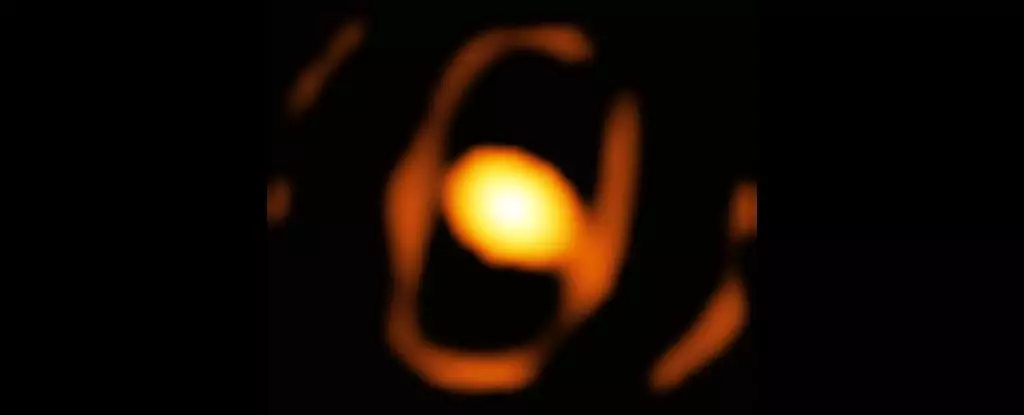In an extraordinary feat of astronomical observation, scientists have captured the first detailed portrait of WOH G64, a colossal red supergiant star residing in the Large Magellanic Cloud, which is a dwarf galaxy neighboring our own Milky Way. This newly-acquired image marks a pivotal achievement in the field of astrophysics, enabling researchers to study a celestial body roughly 160,000 light-years from Earth. Dubbed “The Monster” for its impressive dimensions, WOH G64 boasts an astonishing radius nearly 2,000 times that of the Sun, underscoring its potency as an object of study. Equipped with cutting-edge technology, the Very Large Telescope Interferometer (VLTI) stationed at the European Southern Observatory has provided a level of insight previously deemed unattainable.
WOH G64’s sheer enormity offers unprecedented observational opportunities that have long eluded scientists. For context, consider Betelgeuse, another red giant located merely 650 light-years away. While Betelgeuse is approximately 764 times the radius of the Sun, it’s a more familiar target leading to a significant amount of fuzzy scientific imagery. In contrast, WOH G64, being approximately 250 times farther and nearly three times larger than Betelgeuse, presents unique challenges and advantages for astrophysical study. Such discrepancies in distance and scale highlight the challenges in imaging even the nearest stars, let alone a behemoth like WOH G64, illuminating the significant technological advancements needed to capture it.
Researchers working on this colossal star utilized a special instrument known as GRAVITY, designed specifically for detecting faint celestial objects. The observations taken in December 2020 were just the starting point; the subsequent phase involved meticulous work in cleaning and reconstructing the gathered data. This process yielded an image that, while still appearing somewhat fuzzy, is rich in groundbreaking details. As observed by Keiichi Ohnaka from Andrés Bello National University in Chile, the recent image uncovered an egg-shaped cocoon of material enveloping WOH G64, which could be linked to substantial mass ejections prior to the star’s eventual supernova explosion.
The red supergiant phase is a critical time in the lifecycle of massive stars, typically those with initial masses ranging from 8 to 35 times that of our Sun. At this stage, WOH G64 is entering a period of instability characterized by violent mass loss. Historical observations recorded in 2005 and 2007 indicated a cloud of dusty material surrounding the star. Recent findings indicate that WOH G64 has been experiencing significant dimming over the last decade, providing an invaluable opportunity to directly observe the evolutionary processes impacting the star in real-time. This dimming might be attributed to the stellar material expelled being dense enough to obscure some of its emitted light.
The peculiar egg-like shape of the ejecta bubble presents an intriguing conundrum for scientists. Initial models predicted a different geometry for the surrounding material, urging a reevaluation of existing theories on mass loss in red supergiants. The cause of the unexpected shape remains speculative; various possibilities exist, ranging from unique ejection mechanics to unseen gravitational influences from a potential binary companion star. The ability to capture this real-time evolution is invaluable, as the mass loss stage can extend for a few thousand years, providing a fleeting window into the final acts of massive stars.
The study of WOH G64 holds promise for unlocking insights into the life cycles of massive stars and their explosive ends. Each discovery sheds light on longstanding astronomical puzzles regarding star formation, evolution, and the mechanics of supernovae. As researchers continue to unravel the mysteries surrounding this gigantic star, they anticipate that further studies could reveal even more about the life-cycle processes of stars that were previously hidden from view. WOH G64 stands not only as a testament to extraordinary scientific achievement but also as a beacon of hope for future discoveries in the vast cosmos.
As we continue to pioneer frontiers in observational astronomy, the lessons derived from WOH G64 will undoubtedly resonate throughout the scientific community, shaping our understanding of the universe and its transient inhabitants.

